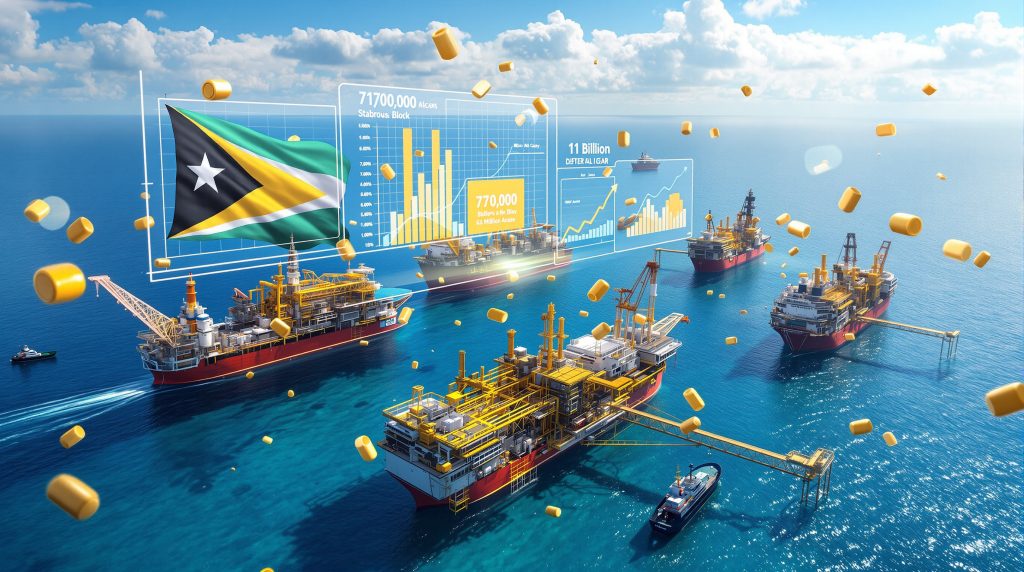Guyana's Offshore Energy Revolution
South America's newest petro-state exemplifies how strategic offshore discoveries can transform national economies within a single decade. The transformation from agricultural nation to major oil producer demonstrates the profound impact of world-class hydrocarbon discoveries when combined with favourable investment conditions and operational excellence.
Furthermore, this remarkable transition occurs against a backdrop of global US oil production decline and shifting market dynamics that have created new opportunities for emerging producers.
ExxonMobil Stabroek Block Guyana serves as the primary operator of a consortium controlling the Stabroek Block, a 6.6-million-acre deepwater territory containing extraordinary petroleum resources. This partnership includes Chevron-owned Hess with a 30% stake and China National Offshore Oil Corporation holding 25%, whilst ExxonMobil maintains operational control with its 45% working interest.
Current production milestones reflect unprecedented development speed in the offshore industry. September 2025 output exceeded 770,000 barrels per day across four operational floating production storage and offloading vessels, representing 14.5% of ExxonMobil's global production portfolio and positioning the Stabroek Block amongst the world's most significant recent discoveries.
World-Class Asset Fundamentals
Geological Excellence and Resource Quality
The Stabroek Block contains verified recoverable reserves exceeding 11 billion barrels across multiple proven discoveries. These reserves support current development projects extending through 2029, with additional exploration potential suggesting further resource additions.
Golden Arrowhead crude oil extracted from these deepwater reservoirs exhibits exceptional commercial characteristics that command premium market pricing. The petroleum stream carries an API gravity of 36.5 degrees, classifying it as light crude particularly compatible with modern refining configurations designed for lighter feedstocks.
Key Quality Specifications:
• Sulfur content: 0.25% (sweet crude designation)
• Carbon intensity: 9 kilograms CO2 per barrel extracted
• Global upstream average: 18 kilograms CO2 per barrel
• Emissions advantage: Approximately 50% lower than industry standard
This combination of light, sweet characteristics with exceptionally low carbon intensity creates significant competitive advantages in increasingly environmentally conscious global markets. The low emissions profile positions Golden Arrowhead crude favourably against heavier, more carbon-intensive production streams.
Strategic Infrastructure and Location Benefits
Deepwater positioning in Guyana's territorial waters necessitates floating production storage and offloading vessel-based development rather than fixed platform infrastructure. This approach enables rapid capacity scaling through successive vessel deployments without requiring extensive permanent installations.
In addition, the FPSO-based production model allows each development phase to operate independently whilst contributing to overall block capacity. Geographic compartmentalisation across multiple fields enables parallel development activities, accelerating overall production growth compared to traditional sequential development approaches.
Development Timeline Achievement
Discovery to Production Acceleration
ExxonMobil achieved remarkable development speed by advancing from initial Liza-1 discovery in 2015 to first commercial production in December 2019. This four-year timeline contrasts sharply with typical decade-long development periods characteristic of comparable offshore discoveries globally.
Development Milestones:
• 2015: Liza-1 commercial discovery establishes Stabroek Block potential
• December 2019: Liza Destiny FPSO commences first production
• February 2022: Liza Unity FPSO adds 220,000 bpd capacity
• November 2023: Prosperity FPSO begins Payara field production
• August 2025: ONE GUYANA FPSO initiates Yellowtail development
Production Scaling Strategy
Sequential FPSO deployment enabled systematic capacity expansion without waiting for comprehensive infrastructure completion. Each vessel operates as an integrated production system incorporating drilling, processing, storage, and export capabilities within a single platform.
Monthly production progression during 2025 demonstrates effective ramp-up execution. August production reached 685,000 barrels per day, increasing to over 770,000 barrels per day by September, reflecting ONE GUYANA FPSO's successful operational integration and production optimisation.
Current Operational Capacity
Active FPSO Fleet Performance
| FPSO Vessel | Development Project | Daily Capacity | Operational Status |
|---|---|---|---|
| Liza Destiny | Liza Phase 1 | 120,000 bpd | Full operations since December 2019 |
| Liza Unity | Liza Phase 2 | 220,000 bpd | Full operations since February 2022 |
| Prosperity | Payara | 220,000 bpd | Full operations since November 2023 |
| ONE GUYANA | Yellowtail | 250,000 bpd | Production ramp-up phase |
| Total Fleet | Four Projects | 900,000 bpd | Combined nameplate capacity |
Production Growth Trajectory
Current output levels demonstrate steady progression toward maximum operational capacity. September 2025 production of 770,000+ barrels per day represents approximately 85% utilisation of total installed capacity, with remaining growth anticipated through continued ONE GUYANA optimisation during the fourth quarter.
However, global market conditions continue to influence strategic planning as OPEC market influence and broader oil price dynamics shape production decisions across the industry.
The 85,000 barrel per day monthly increase between August and September 2025 reflects systematic production ramp-up procedures typical of new FPSO commissioning. This 12.4% monthly growth rate indicates successful vessel integration and reservoir performance meeting design expectations.
Financial Performance and Profitability
Economic Fundamentals
Stabroek Block operations demonstrate exceptional economic metrics that ensure profitability across diverse market conditions. The approximately $30 per barrel breakeven cost positions these assets amongst the lowest-cost global production sources, enabling sustained profitability even during challenging price environments.
Financial Framework Components:
• Breakeven price: Approximately $30 per barrel
• Royalty rate: 2% under Production Sharing Agreement
• Cost recovery: Up to 75% of annual production covers development expenses
• Total committed investment: $60 billion across all planned projects
Earnings Impact Analysis
Third-quarter 2025 financial results demonstrate ExxonMobil Stabroek Block Guyana's critical importance to ExxonMobil's overall performance. Despite upstream earnings declining 7.8% year-over-year to $5.7 billion due to lower global oil prices, growing Guyana production provided substantial earnings stability.
The Production Sharing Agreement with Georgetown includes exceptionally favourable terms compared to international standards. The 2% royalty rate combined with the 75% cost recovery mechanism creates front-loaded financial returns during the development phase, accelerating capital recovery timelines.
Key Financial Metrics (Q3 2025):
• Upstream earnings: $5.7 billion (down 7.8% year-over-year)
• Nine-month earnings: $17.8 billion (down 5.6% year-over-year)
• Quarterly dividend: $1.03 per share (4% increase)
• Annual dividend yield: 3.5%
Estimated cost recovery through mid-2025 approaches $40 billion, representing approximately 67% of total committed capital across all Stabroek Block developments. This recovery rate demonstrates the project's strong cash generation capabilities and the effectiveness of the PSA structure.
Future Development Pipeline
Near-Term Project Expansion (2026-2029)
Uaru Development (Project 5)
Expected commissioning during 2026 will introduce the Errea Wittu FPSO with 250,000 barrels per day nameplate capacity. This $12.7 billion investment includes comprehensive drilling and infrastructure programmes supporting long-term production sustainability.
Whiptail Development (Project 6)
Scheduled for 2027 startup, the Whiptail project features the Jaguar FPSO currently under construction. The $12.7 billion development will add another 250,000 barrels per day capacity through advanced deepwater production technologies.
Hammerhead Development (Project 7)
The seventh Stabroek Block project received final approval in September 2025, targeting 2029 production commencement. This $6.8 billion investment will contribute 150,000 barrels per day capacity, bringing total block capacity to 1.5 million barrels per day.
Long-Term Expansion Vision
Upon Hammerhead project completion, total Stabroek Block capacity will reach 1.5 million barrels per day, establishing Guyana as South America's second-largest oil producer behind Brazil. Additional exploration activities continue across the 6.6-million-acre block, suggesting potential for further discoveries and development phases.
Furthermore, eight total developments are planned across various Stabroek Block fields, with combined investments approaching $60 billion. This systematic expansion approach ensures sustained production growth whilst maintaining operational flexibility for future opportunities.
Economic Transformation Impact
Employment and Local Business Development
Stabroek Block operations have generated substantial employment opportunities within Guyana's energy sector. Over 6,200 Guyanese workers comprise approximately 70% of the total workforce, demonstrating significant local hiring commitments and skills development initiatives.
Local business engagement encompasses more than 2,000 Guyanese companies participating in various supply chain activities. Combined supplier spending exceeds $2.9 billion since 2015, creating substantial economic multiplier effects throughout the domestic economy.
Government Revenue and Sovereign Wealth
Guyana's Natural Resource Fund has accumulated deposits exceeding $7.8 billion since 2019, establishing a substantial sovereign wealth foundation. Future revenue projections anticipate significant increases as cost recovery phases complete and profit-sharing mechanisms become more prominent.
Economic transformation metrics demonstrate remarkable national development acceleration. Double-digit GDP growth rates position Guyana as South America's wealthiest nation per capita, reflecting the profound impact of world-class hydrocarbon discoveries on national economic trajectories.
Infrastructure and Skills Enhancement
Technology transfer programmes and training initiatives develop local technical capabilities essential for sustained energy sector participation. Port facilities, logistics infrastructure, and specialised maritime services have expanded significantly to support offshore operations.
Educational partnerships with international training organisations provide Guyanese workers with advanced technical skills applicable across the global energy industry. These investments create long-term human capital development beyond immediate project requirements.
Environmental and Sustainability Considerations
Carbon Footprint Management
Golden Arrowhead crude extraction demonstrates significantly lower emission intensity compared to global upstream production averages. The 9 kilograms CO2 per barrel extraction rate represents approximately half the 18 kilograms per barrel industry standard, reflecting efficient production processes and favourable reservoir characteristics.
Natural gas utilisation projects, including planned Longtail development, will further enhance environmental performance by capturing associated gas for productive use rather than flaring. These initiatives align with international best practices for offshore development sustainability.
Marine Environment Protection
Deepwater drilling operations incorporate comprehensive environmental monitoring protocols and marine protection measures. Biodiversity conservation initiatives address potential impacts on surrounding marine ecosystems through science-based management approaches.
Regulatory compliance frameworks align with international offshore development standards whilst addressing specific regional environmental conditions. Ongoing environmental impact assessments guide operational modifications to minimise ecological disruption.
Regional Production Context
What Makes South American Energy Leadership Unique?
Current regional positioning places Guyana amongst emerging major producers within South America's energy landscape. By 2029, projected production levels will establish Guyana as the continent's second-largest oil producer, surpassing traditional producers like Venezuela, Colombia, and Ecuador.
Regional Competitive Advantages:
• Political stability: Consistent investment-friendly policies
• Modern infrastructure: Advanced technology deployment capabilities
• Favourable fiscal terms: Attractive international investment conditions
• Operational efficiency: Proven rapid development capabilities
Strategic Market Position
Deepwater production capabilities position Guyana favourably against mature regional producers facing declining reserves or operational challenges. Modern FPSO-based infrastructure provides operational flexibility and expansion potential exceeding traditional fixed platform limitations.
In contrast to policy uncertainties affecting other regions, such as ongoing debates around Alaska drilling policy, Guyana maintains consistent regulatory frameworks that support long-term investment planning.
Proximity to major global shipping routes enables efficient crude oil transportation to international markets, supporting premium pricing for Golden Arrowhead crude quality. Strategic geographic positioning enhances market access compared to landlocked or geographically constrained production regions.
Challenges and Risk Assessment
Technical and Operational Risks
Deepwater drilling complexity requires specialised expertise and equipment capable of operating in challenging marine environments. Weather dependencies and seasonal operational windows create scheduling constraints affecting development timelines and production optimisation.
FPSO maintenance requirements and operational continuity planning become increasingly complex as fleet size expands. Coordinated maintenance scheduling across multiple vessels whilst maintaining production targets requires sophisticated operational management.
Workforce scaling and local capacity development present ongoing challenges as production expansion continues. Balancing international expertise requirements with local employment commitments requires sustained training and development investments.
Market and Economic Considerations
Oil price volatility directly impacts project economics despite favourable breakeven costs. Extended low-price scenarios could affect future development decisions and investment timing, although the $30 per barrel breakeven provides substantial downside protection.
Global energy transition trends and long-term demand outlook create strategic planning uncertainties for major capital investments. Competition from renewable energy sources and changing transportation technologies may influence long-term market dynamics.
Regional competitive pressures from other low-cost production areas require continuous operational excellence and cost management. Maintaining competitive advantages through technology advancement and operational efficiency becomes increasingly important as global supply increases.
Geopolitical and Regulatory Factors
Regional border disputes and territorial claims create potential diplomatic complications affecting operational security and investment climate stability. International arbitration processes may influence future development permissions and operational frameworks.
Environmental regulations and international climate commitments could impose additional operational constraints or carbon pricing mechanisms. Adapting to evolving regulatory frameworks whilst maintaining commercial viability requires flexible operational planning.
Local content requirements and community relations management present ongoing stakeholder engagement challenges. Balancing international operational standards with domestic economic participation expectations requires careful policy coordination.
Global Energy Market Significance
The ExxonMobil Stabroek Block Guyana represents one of the most significant offshore discoveries of the past decade, fundamentally altering global supply dynamics and demonstrating the continued potential for major conventional hydrocarbon finds. Production milestones achieved through 2025 establish Guyana as a critical new supply source in international energy markets.
This success contrasts with challenges facing other regions, including energy export challenges experienced by traditional producers adapting to changing global dynamics.
Economic transformation experienced by Guyana illustrates the profound development potential of world-class energy discoveries when combined with favourable investment conditions and operational excellence. Double-digit GDP growth rates and sovereign wealth accumulation provide a model for resource-rich developing nations seeking sustainable economic advancement.
ExxonMobil Stabroek Block Guyana's operational success enhances the company's global portfolio diversification whilst generating substantial cash flows supporting shareholder returns and future investment capabilities. The combination of low breakeven costs, favourable fiscal terms, and expanding production capacity positions these assets as long-term value drivers.
As noted by industry analysts, the project's exceptional economics and rapid development demonstrate how strategic offshore discoveries can reshape regional energy landscapes and create sustainable competitive advantages.
Disclaimer: This analysis is based on publicly available information and should not be considered investment advice. Oil and gas investments carry inherent risks including commodity price volatility, regulatory changes, and operational challenges. Future production targets and financial projections are subject to various uncertainties and may not be achieved as anticipated.
Ready to Capitalise on the Next Major Energy Discovery?
Discovery Alert's proprietary Discovery IQ model delivers instant notifications on significant ASX mineral discoveries, enabling subscribers to identify actionable opportunities ahead of the broader market just as major finds like ExxonMobil's transformative Guyana discoveries revolutionised entire regions. Begin your 30-day free trial today to secure your market-leading advantage with Discovery Alert's comprehensive exploration opportunities.




